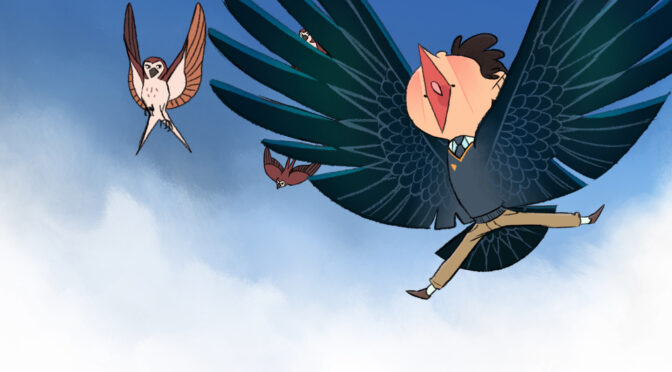 Growing up is never easy, especially when you’re deemed an outcast. In competition at Tribeca this year was CORVINE, an animated short from first-time writer-director Sean McCarron about finding your wings in a world that tears you down.
Growing up is never easy, especially when you’re deemed an outcast. In competition at Tribeca this year was CORVINE, an animated short from first-time writer-director Sean McCarron about finding your wings in a world that tears you down.
Within its brisk ten-minute runtime, McCarron is able to translate the pain of growing up as a deviant; one not fully welcome within the will of society. While there’s no dialogue (the film is free of any at all) to confirm it, the little boy at the heart of this story comes across as neurodivergent. The unnamed boy – of roughly 5-6 years of age – is obsessed with crows (‘corvine’ pertaining to the characteristics of the crow, raven and jay family). The obsession doesn’t stop at merely admiring them, and extends to the boy’s actions. The boy mimics the birds, copying their every mannerism, from squawking like them to sharing his food. This is all shown in exciting and imaginative sequences evoking the wild and free imagination that children have. Infatuation is a common trait across different aspects of neurodivergence, where a single enjoyment can snowball into obsessive fixation. The boy’s inability to read social cues, as he begins squawking incessantly in a classroom setting, deepens this story, especially when the non-verbal boy is bullied for his awkward unfamiliarity with socialising outside of his corvine brethren.
As previously mentioned, the ten-minute runtime doesn’t have much room for idle storytelling so the child’s neurodivergence isn’t expressed through words. McCarron, whose experience lies with Oscar-winning animation studios Mikrofilm and Cartoon Saloon (of whom the style of minimalistic hand-drawn animation feels inspired by and indebted to), instead utilises a gorgeous orchestral score courtesy of Suad Bushnaq to help bring this sweet tale to vibrant life.
With prior film festivals awarding the short, including Calgary Film Festival, where it earned the audience award, and Festival International du Film pour Enfants de Montreal, where it won the professional jury prize, the film has had a successful trajectory across the short animated film landscape. CORVINE is a delightful and succinct short full of heart, and flies high with a full plume of imagination.
Sean McCarron spoke about the film, his time working on Cartoon Saloon’s SONG OF THE SEA and the Oscar-winning THE BREADWINNER and how the film’s portrayal has already resonated with several children on the autistic spectrum.
Connor Lightbody: How long was your process on this, from your original inspiration to the final cut?
Sean McCarron: 8 years, in total.
CL: So your production was all through your work on SONG OF THE SEA and THE BREADWINNER?
SM: That’s correct, yes. So, yeah, I had the initial idea in 2014, and it just started off as a small idea and I started working on it around my full-time work. It was just something to kind of let me be free. Industry work is nice and working on those big projects are wonderful, but they’re very deadline-orientated and you want to try and do more when you’re inspired by the people around you. You just want to get in there and do more in the industry.
CL: It sounds like you had a lot of flexibility on this then?
SM: Yes, absolutely. I wanted to push myself and it started just as a project where I wanted to do more storyboards, more design, more backgrounds: to do almost everything really.
CL: That’s great. So in 2014, what was that original inspiration?
SM: It started off with my wife, actually. When we met, she was very good at crosswords and word puzzles and so I would always try and keep up, which was difficult because, you know, she’s still so much better than me – I’m getting better! – but I remember the first clue that I got right before her and it was a seven-letter word for crow-like and that, of course, is ‘corvine’, so you know, of course I had to make a film about it! Yeah, it just sparked off this funny little thing that my dad used to do, that when I was telling my wife that when I was younger, my dad would go out in the yard and he would mimic the crows and call out to them. They would listen, fly around, call back, and then fly in for a closer look. And we just thought this was hilarious. Years later he came to visit, and I told him that we were doing this film and do you want to do the voice? So I recorded him and that’s his voice as the little boy.
CL: Well you’ve just answered another one of my questions there, about how you got the squawks for the little boy, as they go up and down and fluctuate in pitch. So, it was your father?
SM: Yeah, my father. He came out to visit us in Ireland, while working at Cartoon Saloon, and we got him into a soundbooth one day and recorded him doing the bird calls.
CL: That’s really cool! Keep it in the family, so to speak.
SM: Yeah exactly!
CL: And something that’s quite independent and smaller scale, it’s always good to get some free labour from your family!
SM: Ha! Yeah that’s it, yeah. It was really funny because he’s always been kind of person to be happy to help and do the crow voice. He’s very outgoing and like a class clown, really, and I got him into the sound booth and it’s the first I’ve ever seen him a little shy and reserved. Yeah it was a fun little turn around.
CL: So you said that the phrase ‘corvine’ came from a crossword – did you research any other birds like a Jay or was it always crows from the genesis, from the start?
SM: It was, yes. When I was coming up with it, the character came up into my head and all the situations he’d get in like what if this kid went to school sounding like this. And yeah it just felt kind of natural because I needed this character to have a graceful, smart intelligent side but I needed something would set him aside and be kind of …you could believe it could be kind of obnoxious. And you know, the crow kind of works: you know it has those two things. They’re intelligent but they do not have pretty voices. A lot of people find them annoying but I thought it worked really well for the story I wanted to tell.
CL: I’d love to know more about your experience working at Cartoon Saloon and Mikrofilm. What experience and lessons did you get from working there and what of that was brought into CORVINE?
SM: Oh my god – sso much. I owe so much to them both. I was with them for 8 years. It’s where I did my first feature film, when I worked on SONG OF THE SEA.
CL: I’m a big fan of the Cartoon Saloon filmography.
SM: Yeah, so you’re aware of their style and CORVINE has a lot of those inspirations and similarities in the background and the likes of that and being surrounded by all of that made me want to try my hand. Theres a lot in that, in CORVINE, that I owe to the stylings of Cartoon Saloon.
CL: I really wanted to talk about how the idea came about – in the opening sequence – of him falling into the field and the little bird silhouette appears in the wheat?
SM: Yes the wheat!
CL: I loved that, it was such a sweet little moment as much as a child jumping off a rock can be sweet. Was that always there, at the storyboard level too?
SM: No, it wasn’t in the initial storyboard. When you’re working independently and doing so much along the stages that you have complete control on, when you have another idea that sparks up, I can just put it in. So, on the storyboard it was just a little flat circle – which was fine – but when I was animating it I thought why not just make it into a crow. That would be kind of nice, you know.
CL: You have a dialogue-free movie, and one of the things I connected with your protagonist…(pauses) – does he have a name, by the way?
SM: I call him Kevin, simple because of the film UP and the bird, the snipe is called Kevin. I wanted to keep it in the bird family.
CL: That’s so neat. So, Kevin is non-verbal and has an infatuation with crows and birds. These are traits synonymous with neurodivergence and autism. Did that come into your process? Because that was one of the things that I really connected to Kevin over.
SM: To be honest, when I was writing it, no, not really but I deliberately kept it quite general and I think that’s one of the film’s strengths in that I chose the film to be non-verbal for ease and accessibility. You don’t have to speak a particular language, you can generally understand it and I liked that. I kept it general because I keep hearing people connect and seeing people respond to the character in all different kinds of ways. With just the problem of being an outsider rather than whether you’re neurodivergent or autistic or your sexuality or you’ve been targeted by race or anything like that. You have these outsider mentalities.
CL: So the film has won a few awards so far on its festival run. After it plays at Tribeca, do you have any future plans for it?
SM: I am going to continue placing it in as many film festivals as it gets accepted to, that’ll be until the end of the year when the festivals kind of run out After that, I’m kind of weighing my options on it, trying to find if there’s anybody overseas who is in sales and distribution that want to pick it up and take it to places that I’m not all too familiar with. This is my first film so I’m brand new to that side of things. There’s always the possibility of just putting it out into the world and let it live its own life.
It’s my first film and I initially thought that making the film was the big hurdle and then when you have the film it just, magically appears out there but that’s not the case at all of course. It’s a lot of hard work and I’m learning as I go! It’s been a journey, a really nice journey so far. And having [someone] tell me how much they loved the short and want to work with me and it felt like something I just had to do.

